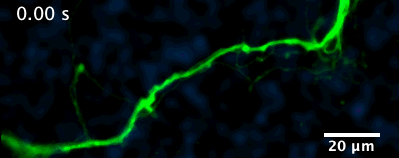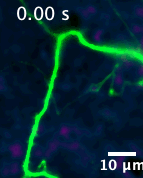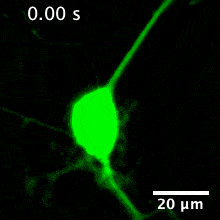Researchers capture the release of dopamine across the entire neuron with unparalleled spatial resolution using new technology developed at Janelia.
Astronomers build new telescopes and peer at the night sky to see what they might find. Janelia Group Leader Abraham Beyene takes a similar approach when looking at the cells that make up the human brain.
Beyene and his team design and synthesize new types of highly sensitive biosensors they use to peer at neurons to see what they can learn.
“You have this new tool that now helps us make the kinds of measurements that we’ve never been able to make before, and we go into the lab and deploy this technology and we see what happens,” Beyene says. “What you see is that some really interesting phenomena begin to emerge that you haven’t even begun to think about.”

Beyene and his team use this approach with their new synthetic nanosensor designed to capture dopamine release across entire neurons with subcellular resolution. The biosensor is attached to a 2D nanofilm, dubbed DopaFilm, and neurons are then grown on top of the film. When the neurons release the neurotransmitter dopamine, the chemical falls onto the film, causing it to brighten. The team then uses a custom-built microscope to capture this brightening, allowing them to visualize dopamine release from any part of the neuron and create movies to capture the chemicals as they get released and diffuse out.
Neurotransmitters that send signals between neurons are typically released from axons, the long chain coming off the neuron’s soma, or cell body. But some neurotransmitters, like dopamine, are also released from the soma and its dendrites – the tree-like structures radiating from it. While previous research demonstrated dopamine is released from the soma and dendrites, traditional methods could not provide a good enough look at exactly where or how this occurred.
Traditional biosensors use proteins targeted to the outer membrane of a neuron, allowing scientists to only observe what is happening at specific points on the cell. But Beyene’s nanosensor is immobilized across a 2D surface, allowing it to record the release of neurochemicals across an entire neuron. The sensor also exhibits extreme sensitivity to dopamine, allowing it to detect even the smallest bit of chemical signal emanating from the cells.


These characteristics allowed the team to capture the release of dopamine in unprecedented detail. The new technique enables them to obtain high-resolution images of dopamine release from axons and see for the first time the release of this important neurotransmitter from specific locations on dendrites.
Their work, reported in a new paper published in eLife, gives scientists an opportunity to take a fresh look at dopamine release from dendrites, and suggests these structures may play a bigger role in brain computations than previously thought.
“We are able to create movies where we capture the full spatial and temporal extent of chemicals as they get released and diffuse, which has never been done before. And then we took advantage of that ability to study the dendritic release of dopamine, which has not been fully characterized and well understood,” Beyene says.
While the new work answers some questions, it also raises new ones, such as why some dendrites release dopamine while others are silent, Beyene says. He hopes their findings prompt new studies by neuroscientists into dopamine neurons in the brain.
“Because most tools struggle to give a good measurement and visualization of release from dendrites, the potential role of dendritic dopamine release in the bigger computation that dopamine neurons undertake has not been fully explored. Hopefully, this study will provide the impetus for researchers to take a second look,” Beyene says.
###
Citation
Chandima Bulumulla, Andrew T Krasley, Ben Cristofori-Armstrong, William C Valinsky, Deepika Walpita, David Ackerman, David E Clapham, Abraham G Beyene. “Visualizing synaptic dopamine efflux with a 2D composite nanofilm.” eLife, Version of Record published August 8, 2022. DOI: 10.7554/eLife.78773
Media Contacts
Nanci Bompey







